一、Pull Up Field(字段上移)
两个子类拥有相同的字段。将该字段移至超类。
二、Pull Up Method(函数上移)
有些函数,在各个子类中产生完全相同的结果。将该函数移至父类。
1、检查待提升函数,确定它们是完全一致的。
2、如果特提升函数名不同,修改与父类相同的函数名。
3、在父类新建一个函数,将待提升的函数代码复制到到新函数中。
4、编译。
5、移除子类中的函数。
6、编译、测试。
7、逐一移除子类中的函数,直到只剩下父类中的函数。
8、编译、测试。
重构后:
三、Pull Up Constructor Body(构造函数本体上移)
你在各个子类中拥有一些构造函数,它们的本体几乎完全一致。在父类中新建一个构造函数,并在子类构造函数中调用它。
1、在父类定义一个构造函数。
2、将子类共同代码搬移到父类中构造函数中。
3、将子类构造函数共同代码删除,改用父类中的构造函数。
4、编译、测试。
class Employee
{
protected string _name;
protected string _id;
public Employee(string name, string id)
{
_name = name;
_id = id;
}
}
class Manager : Employee
{
private int _grade;
public Manager(string name, string id, int grade)
{
_name = name;
_id = id;
_grade = grade;
}
}重构后:
class Manager : Employee
{
private int _grade;
public Manager(string name, string id, int grade)
:base(name,id)
{
_grade = grade;
}
}
四、Push Down Method(函数下移)
父类中的某个函数只与部分(而非全部)子类有关。将这个函数移到相关的那些子类去。
五、Push Down Field(字段下移)
父类中某个字段只被部分(而非全部)子类用到。将这个字段移到需要它的那些子类中。
六、Extract Subclass(提炼子类)
类中的某些特性只被某些(而非全部)实例用到。新建一个子类,将上面所说的那一部分特性移到子类中。
1、为源类定义一个新的子类。
2、为这个新的子类提供构造函数。
3、找出父类的构造函数,如果是需要子类的构造函数,请替换之。
4、逐一使用Push Down Method和Push Down Field将源类的特性移到子类。
5、编译、测试。
class JobItem
{
private int _unitPrice;
private int _quantity;
private bool _isLabor;
private Employee _employee;
public JobItem(int unitPrice, int quantity, bool isLabor, Employee employee)
{
_unitPrice = unitPrice;
_quantity = quantity;
_isLabor = isLabor;
_employee = employee;
}
public int GetTotalPrice()
{
return GetUnitPrice() * _quantity;
}
public int GetUnitPrice()
{
return (_isLabor) ?
_employee.GetRate() : _unitPrice;
}
public int Quantity
{
get { return _quantity; }
}
public Employee Employee
{
get { return _employee; }
}
}
class Employee
{
protected int _rate;
public Employee(int rate)
{
_rate = rate;
}
public int GetRate()
{
return _rate;
}
}
class Program
{
static void Main(string[] args)
{
Employee kent = new Employee(3600);
JobItem j1 = new JobItem(0, 5, true, kent);
}
}
创建一个子类,重构后:
class JobItem
{
private int _unitPrice;
private int _quantity;
private bool _isLabor;
protected Employee _employee;
protected JobItem(int unitPrice, int quantity, bool isLabor)
{
_unitPrice = unitPrice;
_quantity = quantity;
_isLabor = isLabor;
}
public JobItem(int unitPrice, int quantity)
: this(unitPrice, quantity, false)
{
}
public int GetTotalPrice()
{
return GetUnitPrice() * _quantity;
}
public virtual int GetUnitPrice()
{
return _unitPrice;
}
public int Quantity
{
get { return _quantity; }
}
protected virtual bool IsLabor()
{
return false;
}
}
class LaborItem:JobItem
{
public LaborItem(int unitPrice, int quantity, bool isLabor)
: base(unitPrice, quantity, isLabor)
{
}
public LaborItem(int quantity, Employee employee)
: base(0, quantity, true)
{
_employee = employee;
}
public Employee Employee
{
get { return _employee; }
}
protected override bool IsLabor()
{
return true;
}
public override int GetUnitPrice()
{
return _employee.GetRate();
}
}
客户端:
class Program
{
static void Main(string[] args)
{
Employee kent = new Employee(3600);
JobItem j1 = new LaborItem(10, 5, true);
JobItem j2 = new JobItem(10, 15);
}
}
七、Extract Superclass(提炼超类)
两个类有相似特性。为这两个类建立一个父类,将相同特性移至父类。
1、建立一个抽象父类。
2、运用Pull Up Field,Pull Up Method,Pull Up Constructor Boday逐一将子类共同元素上移到父类。
3、编译、测试。
八、Extract Interface(提炼接口)
若干客户使用类接口中的同一子集,或者两个类的接口有部分相同。将相同的子集提炼到一个独立接口中。
1、新建一个接口。
2、在接口中声明待提炼类的共通操作。
3、让相关的类实现其接口。
4、调整客户端的类型声明,令其使用该接口。
class Employee
{
private int _rate;
private bool _isSpecialSkill;
Employee(int rate, bool isSpecialSkill)
{
_rate = rate;
_isSpecialSkill = isSpecialSkill;
}
public int GetRate()
{
return _rate;
}
public bool HasSpecialSkill()
{
return _isSpecialSkill;
}
}
class TimeSheet
{
double Charge(Employee employee, int days)
{
int basic = employee.GetRate() * days;
return (employee.HasSpecialSkill()) ? (basic * 1.05) : basic;
}
}
重构后:
interface IBillable
{
int GetRate();
bool HasSpecialSkill();
}
class TimeSheet
{
double Charge(<span style="color:#ff0000;">IBillable </span>employee, int days)
{
int basic = employee.GetRate() * days;
return (employee.HasSpecialSkill()) ? (basic * 1.05) : basic;
}
}
九、Collapse Hierarchy(折叠继承体系)
父类与子类之间无太大区别,将它们合为一体。
1、选择你想移除的类:父类或子类。
2、使用Pull Up Field,Pull Up Method或Push Dwon Field,Push Down Method,把想移除的行为和属性搬移到另一个类中。
3、编译、测试。
4、调整原类的引用点,改为新类的引用。
5、移除源空类。
6、编译、测试。
十、Form Template Method(塑造模板函数)
你有一些子类,其中相应的函数以相同的顺序执行类的操作,但各个操作的细节上有所不同。将这些操作分别放进独立函数中,并保持它们都有相同的签名,于是原函数也就变得相同了。然后将原函数上移至父类。
1、在各个子类中分解目标函数,使分解后的各个函数不完全相同。
2、运用Pull Up Method将各个子类完全相同的函数上移父类。
3、对于那些完全不同的函数,实施Rename Method,使这些函数的签名完全相同。
4、编译、测试。
5、运用Pull Up Method将所有函数逐一上移到父类,并声明为抽象函数。
6、编译、测试。
7、移除子类中的原函数,编译、测试。
重构后:
十一、Replace Inheritance with Delegation(以委托取代继承)
某个子类只使用父类接口中的一部分,或是根本不需要继承而来的数据。在子类中新建一个字段用以保存父类,调整子类函数,令它改而委托父类,然后去掉两者之间的继承关系。
1、在子类型新建一个字段,引用父类的一个实例。
2、修改子类所有函数,让它们不使用父类,转而使用字段。
3、编译、测试。
4、去除继承关系。
5、编译、测试。
十二、Replace Delegation with Inheritance(以继承取代委托)
你在两个类之间使用委托关系,并经常为整个接口编写许多极简单的委托函数。让委托类继承受托类。
1、让委托端成为受托端的子类。
2、编译。
3、将受托字段设为该字段所处对象本身。
4、去掉简单的委托函数。
5、编译、测试。
6、把调用委托的代码改为对象本身。
7、移除受托字段。
class Person
{
private string _name;
public string Name
{
get { return _name; }
set { _name = value; }
}
public string GetLastName()
{
return _name.SubString(_name.LastIndexOf(' ') +1);
}
}
class Employee
{
Person _person = new Person();
public override string ToString()
{
return "Emp:" + _person.GetLastName();
}
}重构后:
class Employee : Person
{
public override string ToString()
{
return "Emp:" + GetLastName();
}
}









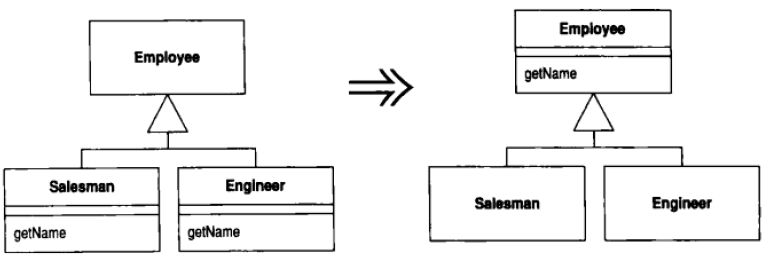
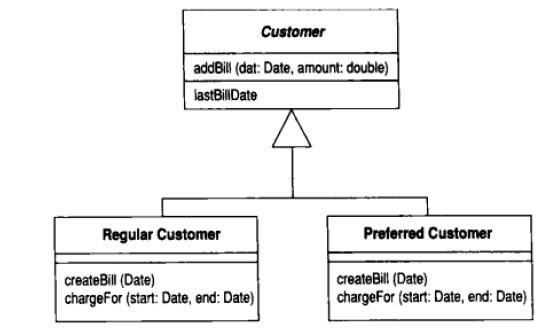
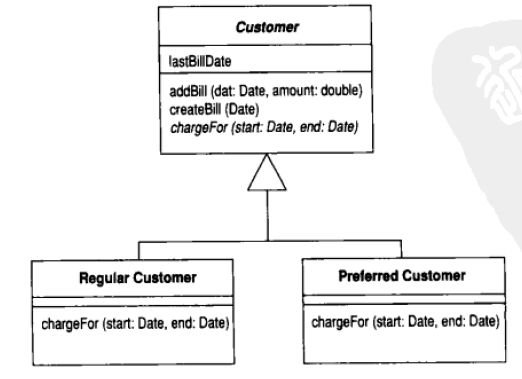

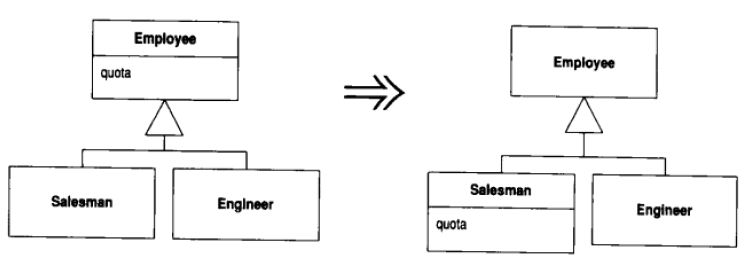

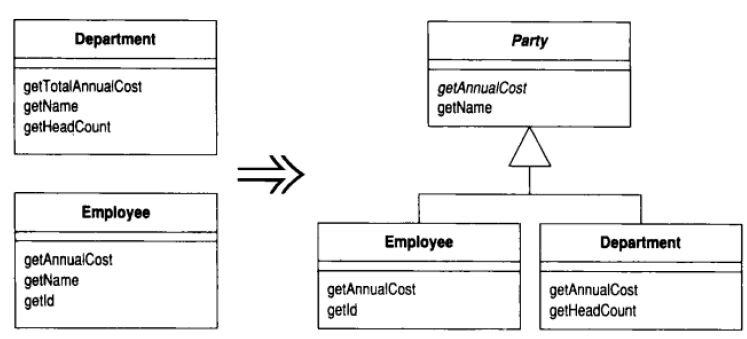
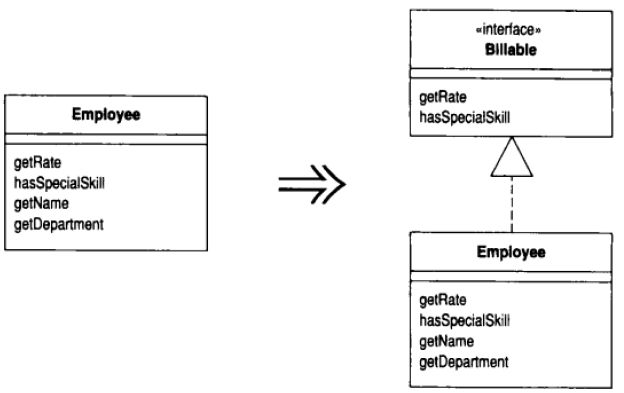

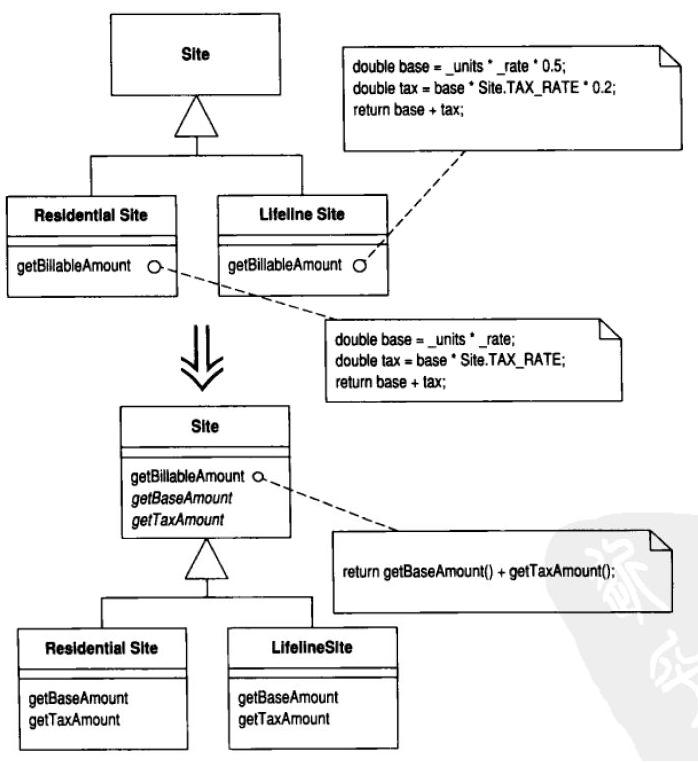
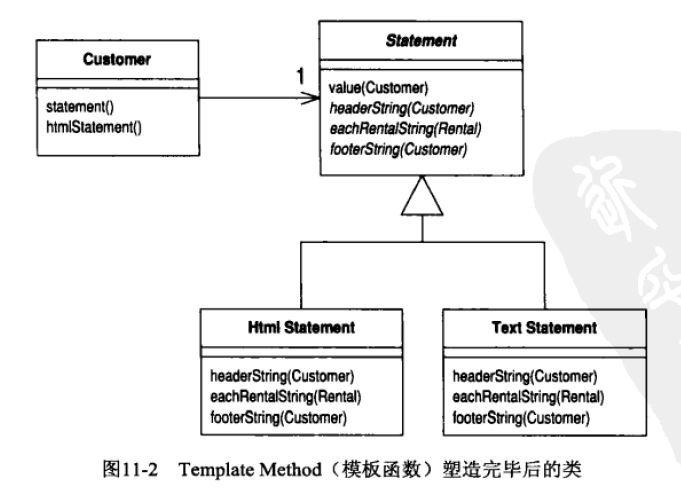
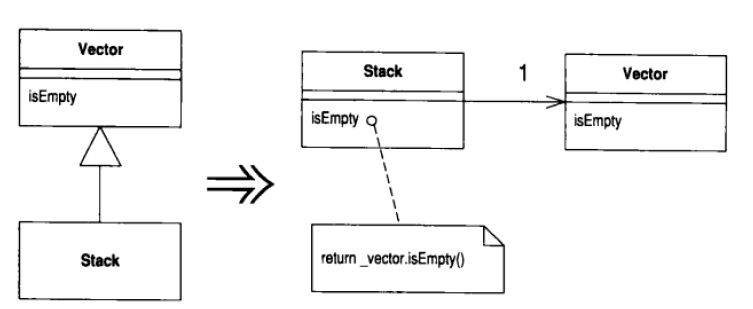















 209
209











 被折叠的 条评论
为什么被折叠?
被折叠的 条评论
为什么被折叠?








